TinBane is back with another great Dropzone Commander article, this time on tank tactics! For more great tactics, check out the Tactics Corner!
In nearly every game of DZC, the most important compulsory unit in terms of damage output, is going to be the main battle tank or equivalent. All four (released) races have a mandatory armoured group to go with the mandatory infantry and command at 1500pts. What do you get for your points, how useful are they, and more importantly, how are they best used?
The Contenders
The UCM Sabre relies on three things to be an effective operator. It has a powerful main gun, with a great combination of accuracy, range and energy. It has the highest possible armour in the game (10). And it has the articulation rule. In effect, the Sabre can fire from behind an object up to 1″ in height with no penalty, and is considered hull down. The major downsides to this unit are it’s dependency on good placement to make use of it’s articulation rule, and it’s low speed. If you are not bringing overwhelming force to bear on a small part of the opposing army, then you need to be holed up in cover to maximise your chances of avoiding damage.
The Hunter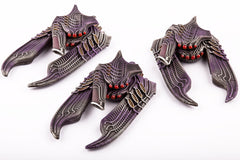
The scourge don’t have the luxury of being an effective anvil unit. With only armour 8, the Hunter can’t afford to be reactive. Each anti-tank shot the enemy takes stands a very good chance of destroying a Hunter, should it connect. The Hunter’s survivability almost entirely revolves around moving the 6″ required to give opponents the +2 penalty to hit a moving skimmer. While out-ranged by all the other main battle tank equivalents, the Hunter has a few advantages of it’s own. It’s speed of 9″ means that it can close devastatingly fast, so fast you can consider fielding them without transport. While their main gun is short ranged, it packs as much punch as the PHR’s railgun technology.
The Tomahawk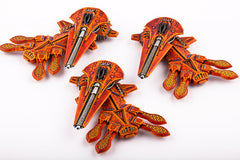
On paper the Shaltari have the same gun as the UCM, which is to say equal “worst”, along with the lowest armour, without having the highest speed. The ace in the hole is their ability to teleport across the battlefield, and a passive countermeasures save (5+) which allows them the chance of bouncing nearly every weapon in the game. In general, between skimmer and their passive countermeasures, they are nearly as tough per point as the Sabre making use of it’s articulation rule. The caveat here of course, is that with only armour 7, heavy anti-air units like the Rapier are more adept at dishing out the pain. Interestingly though, they may be ideal against Scourge/Odin heavy lists where firepower is overwhelming, and the passive bounce and penalty to accuracy will hurt their enemies offensive plans.
The Ares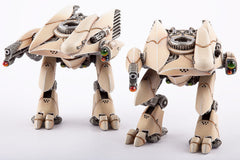
Perhaps one of the most maligned units in DZC at launch, the Ares was a bit of a joke. However, with the addition of a scanner rule and a points drop to 42pts it’s really come into it’s own. But exactly how well does this unit compete, especially given the amount the Shaltari and Scourge outpace it post-drop. The PHR perhaps suffer the most from the temptation for a later-game drop, but maybe that’s a result of being too greedy with Odins?
The Results
For ease of comparison, a brute force approach was used, with 10,000 samples run for every combination of attack and defender. The scale is one where 100% represents the best performing unit per point of cost, weighted by the product of points and probabilities of the targets/damage source. For the Ares, when it is the target partial damage was considered worth 14pts (1/3rd value) but defense the value of the Ares doesn’t consider damage to have any value if it doesn’t knock it out. No weighting was given to speed/range combinations.
The Sabre: Attack – 68%, Defense – 31%, Defense (Articulated) – 37%
The Hunter: Attack – 100%, Defense – 30%
The Tomahawk: Attack – 66%, Defense – 35%
The Ares: Attack – 94%, Defense – 100%
The results display the massive benefit the PHR has in a “fair” fight. On a per-point basis the Ares (with it’s new scanner rules) has 94% of the efficiency of the Hunter. That’s on a PER POINT basis, which means it’s high cost is already factored. And on a per point basis the rest of the field have a staggering 1/3 the survivability (even factoring in damage at a “value” of on third of a kill, the PHR would still be sitting on double the survivability).
What does this mean? An Ares spam list, that simply maxed out Ares as the alpha strike, would still have most of the hitting power of the dreaded hunter rush. So why isn’t it that scary? In other wargames, a statistical disparity of this magnitude would make the game unplayable, or at least, unwinnable.
In Dropzone Commander, it simply forces you to focus on the objectives. If anything, the PHR are the stereotypical “Big Bag” from TV or movies, in terms of their in-game effect. You are competing with an opponent you can’t hope to fight evenly, so you simply have to buckle up and pull the objectives effectively. It also highlights just how much benefit the PHR gain from “kill point” objectives, especially given many PHR players consider the new, improved, cheaper Ares still inferior to the Odin. Perhaps that will be the subject of my next post. Is the Odin better than the Ares mk 2, or is this an example of “internet wisdom” that no longer matches the reality of the game?
EDIT: This article was authored before the release of the new “standard” tanks. I’ll post an updated version in time, perhaps with improved stats and the new units included. Hopefully also some analysis of their movement capabilities.

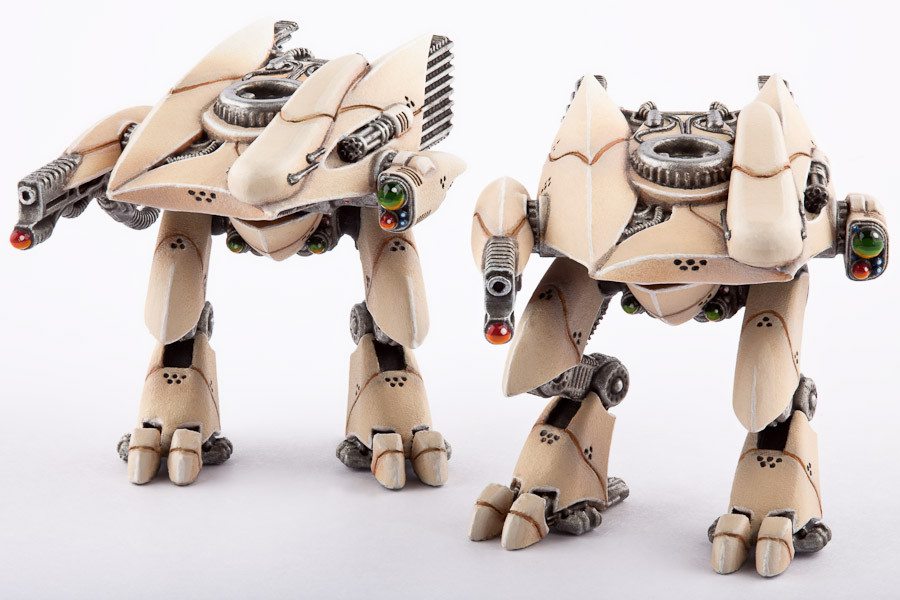
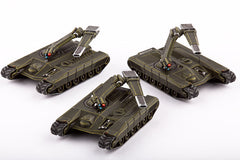
How do you feel about driving on with Tomahawks? I find that it is never worth taking more than 1 of my battle groups as a Sword Point because I need slots of other things in my list. This generally results in Tomahawks being in gate-unfriendly squadrons of 6. It’s actually part of a bigger issue I’m having with my list. I know I’m supposed to be focusing on objectives and do, I take 2 warrior clans for that purpose but my list just does not seem to have a volume of fire necessary to actually hold off against them, even with a Fire Drake.
The numbers make it look like my Sabres really struggle, lol!
Sabres don’t struggle.
Your opponent will nearly always have minimal ares walkers, and if they load up on ares, then hide behind buildings close enough to nip at his heels if he makes the wrong move, and play for the mission.
Against hunters, your main concern is on preventing him from getting close without taking damage first as he closes!
“The Art of War” applies more to DzC than any other game I’ve played. If your opponent spams Ares, force him to drop them turn 1, then refuse to engage on his terms and make him walk.
If he takes too many PHR toys, then fight him!
The katana isn’t a better sabre, it’s an alternative. Cheaper, but the armour is 1 less (which is a big deal) and it fires two shots at one lower E. It’s faster too. Great against skimmers!
Thanks for the thoughtful reply!
Frankie and I just ordered the extra goodies we need to get some armies on the table, today. So, we should have some stuff up and ready to rock in the next few weeks.
My limited experience with Sabres so far has been positive. They hit hard and are durable, but slow as you noted.
Two things you’ll notice most is the loss of the “wound pool” mechanic. Gotta preallocate the shots to each model, within a squad.
Also, DzC has greater variability. Which isn’t a bad thing! I think a big problem with 40k atm is how many options there are that give reliable, favourable results. It makes units with a bit of risk/reward unsound choices. And when you have something as reliable and flexible as a tau gunline or AM gunline, how do you counter that without adding equally risk free defensive units like deathstars?
Oh for sure. A good list in 40K (or any game of chance) is all about reducing variables. The more predictable the results, the more skill comes into play. However, when it is applied unequally, it creates an unfun game like 40k can be when these rules mechanics get out of hand.
I prefer D10 and D20 systems for just the reason you list. You can have a wider range of variability and more variety in unit types.
No worries, as noted at the bottom of the article, this was written before all factions received their new Standard choice. You can find them and their current rules on the hawk site, until the rules are printed of course.
Shaltari received the Tarantula walker, which sports a graviton cannon that damages based on DP (like HP) and armor value. Gives us some punch in the standard department.
I always drive my tomahawks on Zeos. They are fast enough that you probably never have to teleport them. Putting them in a larger group will make them more effective. I tend to think of them as heavy scouts rather than a MBT.
No worries Reecius, USM received the Katanas (I believe that’s the name). I’m pretty sure they are Sabres minus articulation but double the shots. Armor 10 is nothing to sneeze at.
I’, alreadying using 1 group of 6 and I don’t really have the battle groups to spare on more sword points. If taking two groups of 6 is that good what should I be giving up to take it: one of my 2 warrior clans, my warfirst or my arrowhead?
O sorry for any confusion. I agree with you, 1 squad of 6 is good. I cannot see where to make the room in the BG’s. 1 standard, 2 inf, 1 heavy, 1 HQ, 1 scout (forget names) and that fills ya up. That is how I tend to end up w/ my lists. I’ve wondered if you could drop the heavy or the scout to add another standard and go for numbers, but I wouldn’t put 2 squads of T-Hawks in, but 1 of squad of 6 T-Hawks and in the other BG 1 squad of 4 Tarantula.
They are E 9 and A9 though. But cheap! A good option to consider at any rate!
Ar our 10 means that you get some good bounces. The PHR are mainly so tough because they can soak damage. Once you scale up a bit, that becomes less beneficial!
Ah, right on. Those katanas look cool, too.
I really feel it is too easy for everyone but the PHR to go so heavy on target saturation that it becomes impossible to just ignore them as shaltari and focus on objectives in some of the scenarios. I mean literally filling the board with as much stuff as can be crammed into their battle groups. For example if I’m facing a list with 16 Powlers there isn’t anywhere on the board I’m not forced to engage and even with their low stats its still 16 distinct targets and Shaltari cannot bring the weight of fire. Teleporting away is sometimes a possibility but not if securing an objective is involved and not if I’ve already had to leave the table with gates carrying away other objectives/they have be brought down by fast movers.
Love these articles, but I’m still having trouble following your statistical methodology. I’ve taken several stats classes and done a lot of work with monte carlo analysis, so I understand the concepts going on, I’m just not completely sure how you built your model?
I have a feeling that spamming Ares is going to be a superior choice than Odins, especially once you take defense into account, and you account for the amount of times that you will be firing at a skimmer or target that is hull down (which is almost all the time when fighting against a competent player who is using MBT units)
Hey TinBane. My PHR Mega Army came in and I have put a couple lists together for 1500/1510 points but I’m really unsure how I should go. I have a 3 player match on Monday(UCM/Scourge/PHR) and wondered if you had any suggestions on how I should build a good list?
Hey Josh,
I’d suggest you sign up to the frontlinegaming forums! There’s a section for DzC and we have a few PHR players who can give better advice than me! I’m happy to chip in. One major factor is what people in your area tend to field. It seems like DzC has quite variable metas
Rather interesting analysis. The key here is that it is during a fair fight, assuming no one get the first shot which is the Ares main problem. Having the toughest anti-tank doesn help much when the enmy just ignores them and wins on objectives. Getting the Ares in a position where they really helps is a problem and hard to do.